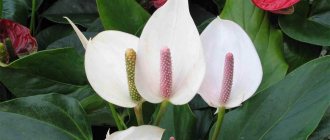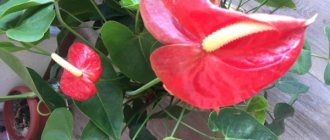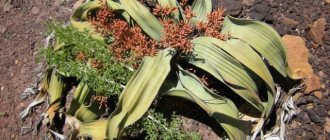Callas are very noble and delicate plants with a unique flower shape. Their homeland is considered to be South Africa. But at the same time, they grow well in our climate not only indoors, but also in garden plots.
Callas can be grown both at home and in the garden
They are popularly called “wedding flowers” or whitewing. Translated from Greek, their name means “beautiful.” It is believed that callas, which bloom regularly, bring happiness, prosperity to the house and bring harmony to family life. Nowadays, many people grow flowers similar to calla lilies. Therefore, it is important to know what they are called and how to distinguish them from each other.
We study varieties of calla lilies - flowers for the bride
Calla lilies are a popular ornamental plant in gardens, greenhouses and potted plants. Callas belong to the genus Zantedeschia, perennial herbs of the araceae family. The popular name of the flower is whitewing. This apt word accurately reflects the appearance of the culture - the large wide petal-veil is most often white and looks like a bird’s wing. The flower comes from equatorial and southern Africa. There it grows in swampy places.
Plant characteristics
Swamp whitewing is a perennial belonging to the araceae family. Aquatic herbaceous plants naturally live near bodies of water, such as rivers and lakes, as well as in wetlands. When grown independently, it is customary to place it near an artificial dam or on a waterlogged part of the site. The flower is very similar to the exotic calla lily, of which it is a relative, which is considered one of its main advantages.
That is why the second name of the calla lily sounds like a marsh calla.
The roots of the whitewing are thick and long, covered with brown scales and numerous shoots. The plant has a central root and lateral fibrous roots that support marsh calla lilies in unstable soils, such as sandy or marshy soils. The upper part of the rhizome with buds is located on the surface. The elongated leaves are heart-shaped and have long petioles. The glossy skin of a light green hue is covered with prominent veins.
General description of calla lilies
Calla, or zantedeschia, is a perennial herbaceous plant up to 2.5 meters high.
The leaves are wide, basal, dark green. Some varieties have leaves covered with white spots. The inflorescence is a yellow spadix on a long peduncle. The flower cover is large, funnel-shaped, white, pink or yellow. Callas are grown in greenhouses and are common in indoor floriculture. Many varieties are suitable for cutting, as they can last in a bouquet for up to a month.
Callas are considered poisonous plants due to their high calcium oxalate content.
The entire plant is poisonous. If calla lily juice gets on the mucous membranes, pain and irritation occur, swelling and a subsequent severe allergic reaction are possible. Contact dermatitis may appear on the skin from the juice of the flower. You should take care of it very carefully, avoiding getting the juice on your skin.
Callas can be propagated by seeds, but most often this is done vegetatively - by dividing the root.
Calla lilies require a period of rest for regular flowering. It lasts from two to six months.
During this period, colored species shed their leaves and completely stop growing, while white callas do not lose their decorative appearance, but stop developing. During the dormant period, colored varieties are stored in a cool place in the form of a dormant tuber, and white varieties are limited in watering.
The following types of callas are common in indoor floriculture:
- Elliot's calla lily;
- Calla Remani;
- Picasso calla;
- Ethiopian calla.
Photos of calla lilies amaze with their variety of shapes and colors. Among them there are snow-white specimens, yellow, red, purple and almost black. Two-color varieties are especially beautiful, when the flower has different shades at the base and edges.
Planting, replanting and caring for indoor callas at home
Planting is carried out before the start of the period of active growth - in April. Planted in separate containers. When planting and caring for indoor calla lilies at home, a thick, at least five centimeters, layer of drainage material - expanded clay, gravel, or broken bricks - should be placed at the bottom of the pot. Plants need a lot of free space, so the pot should be wide, but not too deep. The capacity must be at least three liters in volume.
For planting and caring for callas at home, slightly acidic soil consisting of peat, sand and a small amount of deciduous soil is used.
In the first half of July, the flower is removed from the pot, the old leaves along with the shoots that grow from the rhizome are removed, after which the plant is transplanted into a spacious pot with a nutritious soil mixture. To transplant indoor calla lilies, the soil is made up of garden soil, peat, rotted manure and sand. The desired soil acidity (pH) is not higher than 6.
To form flower stalks, you need at least 12 hours of daylight. After this period, daylight hours for calla lilies should be no more than 10 hours, but not less than 8 hours.
When replanting, it is important that the rhizomes are at the same level as before.
Calla Elliott "Zantedeschia elliottiana"
Calla Elliott has large leaves with white spots and flowers of two shades. The plant is a tuberous plant and is best propagated vegetatively. The variety loves good care - a lot of light, warmth, frequent watering.
The most famous varieties of callas:
- “Vermeer” is highly decorative. The leaves are carved, wavy along the edges, covered with white specks. The stem has a burgundy calla flower, gradually turning white closer to the edges.
- “Yellow corner” - the green stem gradually changes color to yellowish. The cover of the flower is soft yellow, sunny in color. The variety looks great with bright speckled leaves.
- "Black-Eyed Beauty" - a wide light yellow petal with a deep purple center and a corn-yellow stamen. The leaves are dark, strewn with large white spots of irregular shape.
Types of calla lilies
Zantedeschia - Ethiopian calla (Callaaethiopica) . The most famous species, a companion to weddings and anniversaries. A milky white blanket covers a long yellow cob.
Calla Elliot (Callaelliottiana) . Produces many large flowers of rich yellow color. Propagated by tubers.
Swamp calla (Callapalustris) . The rhizome is located on the surface of the ground and is large in size. The cover is snow-white on the inside and green on the outside. It grows quickly, suppressing other plants, and forms a green carpet. Considered poisonous.
Calla Remani (Callarehmanii) . The smallest species, which grows no more than 50 cm in height. The color of the bedspread is red-pink, very bright and rich. This species is the starting material for breeding varieties of different colors.
Calla rehmannii
Calla Remani is a low-growing species. Plants reach a height of no more than half a meter. It has narrow green leaves that are shed in the winter. Propagated by tubers, popular in indoor floriculture.
Known varieties:
- “Evening” is the name given to a variety of calla lilies with dark purple, almost black flowers.
- “Indian Summer” is an unusual and rare variety of red calla lily with a garnet hue.
- “Chameleon” fully lives up to its name - the flowers shine in all shades of peach and golden tones. Dark green leaves are covered with white specks.
- “Picasso” is a variety of calla lilies 35-45 cm high. Large burgundy flowers with a light border bloom in July-September and bloom for up to a month and a half.
- Black Forest - this variety has large candle-shaped flowers of a burgundy-violet hue.
- "Anneke" - beautiful funnel-shaped flowers in a pink-violet hue.
How to replant callas
Planting an adult plant with leaves and a separate bulb in a pot is slightly different.
How to replant a store-bought flower:
- The flowerpot needs to be roomy: about 20 cm is allocated for one bulb.
- It should be a little higher in height to provide a few centimeters of drainage.
- The plant is carefully shaken out of its original container.
- The flower is placed in the center and covered with soil. It is advisable to leave the upper quarter above the surface.
- You can plant several flowers of the same type in one pot.
The peculiarity of calla lilies is long-term stress after transplantation, when the flower does not begin to grow . At this time, you don’t need to stimulate it, just keep it on the window and water it on time.
Before planting calla bulbs in a pot, they are first disinfected in a solution of potassium permanganate. The seedling is kept in it for 1 hour, then dried at room temperature. After planting, the calla lilies are covered with film, and only the dried soil is watered.
Zantedeschia requires loose soil: a mixture of sand, humus and leaf soil in equal parts.
Ethiopian calla (Zantedeschia aethiopica)
Calla Ethiopian is the largest variety of Zantedeschia for growing indoors. This species has large heart-shaped leaves and funnel-shaped inflorescences. During the dormant period, the foliage remains bright green, which increases the decorative appearance of the species.
The most famous varieties of Ethiopian calla lilies include:
- “Green Goddess” is a variety with white-green flowers and a short lemon-colored stamen.
- “Childsiana” - the variety blooms profusely with snow-white flowers with an orange center.
- “Amethyst” is a variety of purple calla lilies that are distinguished by their considerable height and delicate aroma.
- “Pearl” is a tall variety with light green leaves, the flowers are large, white, fragrant, with a greenish tint on the outside. Suitable for bouquets.
- "Albomaculata" - a large white flower with a candle shape and a light vanilla aroma.
- "Captain Chelsea" is a beautiful two-color variety. The bedspread is burgundy with a golden border. The leaves are dark green with silver dots.
- "Little Gem" - calla has white flowers of the original appearance. A flower that has not fully blossomed has a petal that curls like a funnel, with a bright yellow stamen in the middle. At the edge of the petal there is a greenish outgrowth-claw.
Varieties of indoor plants
All varieties of calla lilies are divided into groups: white and colored.
There are 5 main types of calligraphy:
- Ethiopian: a heat-loving species with tall shoots up to 80 cm in height and large fleshy leaves, white spathes with a yellow base. The most popular variety of calligraphy here is called “Green Goddess”. This flower is often used by florists to create wedding bouquets.
- Elliott: medium-sized plant with heart-shaped leaves, flowers are contrastingly colored: the bases of the bracts are yellow-green, the tops are lemon or cream. Flowers of this variety love sunlight and are best grown on open windowsills.
- Remanna: a miniature variety about 30 cm high, the leaves are covered with contrasting light spots, the bracts are bright pink or variegated. From these flowers, variegated hybrid varieties from pale pink to dark lilac are bred.
- Amethyst: A showy variety with large, shiny leaves and funnel-shaped bracts in shades of blue, blue or maroon.
- Swamp calla: the plant is extremely poisonous, grows quickly and consumes everything around it. This species is distinguished by a white flower with a green cylindrical spadix that looks like a cactus.
How to plant calla lilies correctly
Purchased tubers should first be kept in potassium permanganate diluted until pink, and then placed for a couple of hours in a solution of the Kornevin stimulant or any other. The plant requires a fairly large volume of soil - about 2.5 liters per tuber. Drainage is poured into the bottom of the pot, then nutrient soil. The calla tuber is smooth at the bottom and has small protuberances at the top. The tuber should be placed with the smooth side down in moist soil.
The planting should be shallow, the tuber is only covered with a layer of soil no more than 1-2 cm. Otherwise, there is a high risk of root rotting.
Immediately after planting, calla lilies are not watered; the pot is left in a warm place without drafts. In the future, calla flowers need regular watering. The plant also needs to be fed with complex flower fertilizer.
Video selection of varieties and types of calla lilies
Callas are very noble and delicate plants with a unique flower shape. Their homeland is considered to be South Africa. But at the same time, they grow well in our climate not only indoors, but also in garden plots.
Callas can be grown both at home and in the garden
They are popularly called “wedding flowers” or whitewing. Translated from Greek, their name means “beautiful.” It is believed that callas, which bloom regularly, bring happiness, prosperity to the house and bring harmony to family life. Nowadays, many people grow flowers similar to calla lilies. Therefore, it is important to know what they are called and how to distinguish them from each other.
Features of caring for and growing anthurium
Anthurium is considered a special plant, as it differs from its fellow Araceae family. It is distinguished for its exceptional aroma, but also for its abundant and beautiful flowering. Therefore, the plant needs special care.
Choosing a pot and soil
Surprisingly, Anthurium does not like large spaces. When choosing a pot, you should take this feature into account and make sure that the roots are as crowded as possible. If there is a lot of space, the plant will waste energy on root growth, while the soil will begin to oxidize, the tops of the leaves will be sparse, and there will be no flowering. It is better to choose a long pot, as the roots like to grow in length. Anthurium prefers oxygen-saturated soil, so it is replanted annually in the spring. The soil mixture is used with expanded clay. It is good when there is moss or peat in the soil. After transplantation, holes are made along the edge, this helps saturate the ground with oxygen, which promotes active flowering of the anthurium.
Required temperature
The flower comes from tropical places, so it loves warmth and humidity. Throughout the year, the temperature in the room must be maintained so that the flower does not fade and blooms profusely. The required temperature for Anthurium is from 20 to 28 degrees. Direct sunlight is harmful to the plant, so it should be protected from it. In winter, the temperature should be maintained between 13 and 22 degrees. To make the anthurium bloom faster, you can raise the temperature to summer standards. It is only important to take into account that the buds are formed at winter temperatures.
Air humidity
The plant came to us from a tropical area; it also likes high air humidity. It is necessary to provide the plant with good moisture. But the main thing is not to overdo it, otherwise the roots of the plant will begin to rot and it will simply die. To prevent the plant from being completely submerged in water, place moistened pebbles and a pot in the tray. This way the indoor plant will receive the necessary moisture. Also, the plant must be sprayed with a spray bottle, or the leaves must be wiped with a dampened cloth, while making sure that moisture does not get on the inflorescences. If the house has a humidifier, then it is better to place the flower next to it, and the humidity should be more than 75%. This creates a tropical effect for the anthurium.
Lighting
Light affects the flowering of a plant. If there is not enough natural light, the flower will look sluggish. Anthurium loves soft and diffused light. Anthurium is a very soft and delicate plant, so the sun can burn its leaves or even destroy it. The best location for anthurium will be windows facing east; a northwestern location is also suitable. If there are none, the plant can be placed in partial shade. In winter, the flower can be placed on a south window, this will compensate for the lack of light.
Bloom
To make “male happiness” bloom and delight with its beauty, you have to work hard. The plant is very picky about caring for itself; it must always be kept in suitable conditions. In addition, the plant loves feeding. Therefore, let’s consider a few basic rules that will help with care:
- It is better to water the plant with settled water. Do not leave water in a bottle on the windowsill, do not allow it to bloom. You can water the plant with melted snow in winter, rainwater in summer.
- Since the flower loves moisture, and it is not easy to maintain it without allowing the roots to rot, sphagnum is placed on the surface of the soil, which helps prevent the soil from drying out.
- If in the summer there is only a south window, then it is better to darken the place where the anthurium will stand, or move the plant to the corner of the window sill.
- “Male happiness” is very light-loving, so in winter it is necessary to help the plant with a table lamp or diode strip.
- The plant does not like to be moved, so it can only be moved 2 times a year in spring and autumn.
- If the flower begins to bloom, protect it from the sun so that the rays do not hit the leaves.
- During flowering, watering increases, and the leaves are regularly sprayed or wiped with a damp cloth.
Reproduction
Plant propagation must be done very carefully, as there is a risk of destroying the plant. People who do not have experience in this matter should not engage in reproduction on their own.
Reproduction methods
- By rooting the top of the plant
- Dividing the roots of the maternity bush
Trimming
Pruning is necessary for the plant; it is a way to rejuvenate the plant and allow new shoots to sprout. Pruning is carried out after flowering, since the buds have withered and lost their viability and must be removed. This can be done with a small pruning shears or a sharp knife. The bud is cut off at the very base, and the fresh cut is sprinkled with activated carbon. You can also wait until the bud is completely dry and then it can be easily removed from the flower. Anthurium is an incredibly beautiful plant. The beauty of the buds of this plant is indescribable. Requires a reverent and attentive attitude. You shouldn't buy a flower if you don't like caring for indoor flowers.
Description of callas
Callas (Calla) belong to the perennials of the Araceae family. Depending on the type, they can be bulbous or have a rhizome. The shiny, bright green foliage reaches 4 to 15 centimeters in length and 5 to 11 centimeters in width. They are arrow-shaped and may contain white or yellow spots on the outer surface. As a rule, they grow in the form of a basal rosette. Calla flowers have long petioles and a unique structure.
The calla lily inflorescence consists of a yellow spadix and a bract that wraps it in the form of a funnel, like a blanket. It can have a wide variety of colors.
The most popular species grown indoors and in gardens include Ethiopian calla, Remann's calla, and Eliott's calla.
Overview of species
Indoor plants with white flowers are quite numerous and varied. They differ in both appearance and care requirements, but they are united by the white color of their buds.
Azalea
At home, this evergreen shrub grows no higher than 50 cm. Thanks to its lush and long-lasting flowering, the plant has gained extreme popularity. Large azalea buds are simple and double, the leaves are lanceolate, densely pubescent on the reverse side and located on branched shoots. Two varieties are most suitable for home cultivation: Melina (Japanese) and Stella Maris (Indian).
- The Japanese one has a more compact size and a highly decorative appearance; the entire bush is densely strewn with small buds. They can grow either singly or in inflorescences.
- Indian has dark green oval leaf blades and rather large buds. The central petals are strewn with crimson splashes. Flowers can be of different types: simple, double or corrugated.
Gardenia
The evergreen plant can grow either as a compact bush or as a tiny tree. In an apartment, the flower reaches a maximum height of 70-100 cm. Dense small leaves have a glossy surface with pronounced venation and grow in 2 or 3 pieces. The flowers are tubular, with a pronounced pleasant aroma. The most popular variety is the jasmine gardenia.
Large white-cream buds smell strongly of jasmine and form corymbose inflorescences of 4-6 pieces.
The plant belongs to vines, so it needs support. The leaf blades are oval in shape, at first they have a glossy surface and then become matte. The buds are not particularly large, but have an unusual star-shaped shape and form small inflorescences. The flowers are mainly white, but in the middle they acquire red or crimson shades. The following varieties of hoya are suitable for growing indoors: green, beautiful, motoskei.
Spathiphyllum
This striking representative of the aroids is distinguished by a very impressive appearance and the absence of pronounced shoots, very similar to calla lilies. Elongated leaf blades grow almost from the root. The flowers also have a rather unusual appearance: on the flower arrow there is a yellow spadix, wrapped in a white blanket of wide petals. The plant has many varieties, both tall and dwarf.
Among them the most famous are: “Abundantly Flowering”, “Picasso”, “Chopin”, “Sensation”, “Cannoleaf”.
White orchid
The plant is distinguished by a thick stem on which large buds grow. White flowers are rare; most often the petals have an edging or inclusions of a different color. The most popular varieties with white petals include the following:
- “Royal” is distinguished by large flowers, about 15 cm in diameter;
- "Vanda" is characterized by long flowering and a pleasant caramel scent of small flowers;
- “Butterfly” is distinguished by unusual petals, shaped like insect wings;
- "Heron" has flowers that resemble a bird in flight.
Red callas: photo and description
Red callas are flowers of passion. Symbols of love and attraction are a wonderful gift for the one you love. Elegant, sophisticated, they have some kind of attractiveness that makes you look without taking your eyes off, both in a bouquet and standing in a vase at home. They are the perfect creation of nature, the personification of everything chic and attractive! Even in the photo, red calla lilies amaze your imagination with their elegance.
- Kingdom: plants.
- Genus: calla.
- Type: angiosperms.
- Order: Alismatae.
- Class: dicotyledonous.
- Family: araceae.
- Homeland: South Africa. The flower was introduced to America and Europe in the mid-19th century.
- Height: 0.4-1 meter.
- Leaves: dark green, heart-shaped.
- Flowering period: until mid-summer.
- Dormant period: storing tubers in a cool place (dug up).
Description of plants similar to calla lilies
In indoor floriculture, there are several types of plants similar to calla lilies.
Spathiphyllum
Spathiphyllum also belongs to the Araceae family. Depending on the variety, it grows from 50 to 150 centimeters in height. Its bright green or variegated foliage is collected in a basal tuft. It has an ovoid shape, in some varieties its structure resembles corrugation. The length ranges from 25 to 90 centimeters, and the width from 10 to 40 centimeters. A spathiphyllum flower consists of a yellow or greenish-colored spadix and a spathe.
Unlike calla lilies, the spathiphyllum cover has an oval shape and is located vertically. By the end of flowering, its white color turns greenish.
Anthurium
Anthurium is an evergreen plant belonging to the Araceae. It can reach more than a meter in height. Anthurium has shiny, tough, solid foliage of a dark green color. It is heart-shaped and up to 40 centimeters long. The flower spadix may be white, pink or yellow.
Unlike calla lilies, the bract, like the leaves of the plant, is heart-shaped and is located around the cob, perpendicular to it.
The blanket can be white, salmon, pink or purple. But, for some reason, today varieties that have only red flowers are most often grown. People often call them “tongues of fire”, “flamingo flowers” or “men’s happiness”. It is believed that anthurium gives a man strength and brings happiness and good luck to his home.
Zantedeschia
Zantedeschia, like callas, is a perennial flowering plant belonging to the Araceae. Its underground part can be either a rhizome or a bulb. Depending on the type, its bushes can produce stems from 50 centimeters to 1 meter in height.
The foliage of the plant is bright green in color and heart-shaped. The appearance of the flower resembles a calla lily. It consists of a yellow cob and, depending on the varietal variety, can be white, pink, greenish, yellow, cream with a lemon tint, lilac-cherry, dark purple.
Whitewing
Calla palustris is a member of the evergreen perennials of the Araceae family. It is a small compact plant about 30 centimeters tall. Its heart-shaped green foliage in some varietal specimens may be covered with white or yellowish spots. They have a length from 6 to 14 centimeters and a width from 5 to 11 centimeters. The ear of the calla lily, like that of calla lilies, is yellow in color. The inside of the bedspread is painted white, and the outside is greenish.
There are not many indoor flowers that look like calla lilies. But, in addition to the fact that they belong to the same family and have some visible similarities, they also have a number of clearly visible differences, for example, in the shape of foliage and bedspread. Therefore, having studied the features of their structure, you can easily determine their name. This will help determine their further content, which will contribute to the proper development and abundant flowering of plants.
Growing red callas in the garden: care and subtleties
Red calla lilies should be planted in spring, in warm, fertilizer-rich and moist soil, always in a sunny place. You must water them constantly in order for them to grow properly. It is necessary to feed the flower once every three weeks, since not all soils are similar to their native (South African) soil, you should bring this as close as possible. This is all about caring for red callas in the garden.
Place flower beds with white roses nearby and your garden will look like a fairy tale.
Flowers with red and white flowers like calla lilies
Callas are divinely delicate flowers that amaze with their grandeur and nobility.
The image of the bride’s snow-white dress, wrapped in a long stem and emitting the finest, sweet aroma immediately appears in my memory. But what flowers are similar to red callas and what can they be called? Classics of the genre - white callas. Not many people know that they are presented in a wide range of colors; there are varieties of pink, burgundy, yellow, orange and deep red.
There are their similar relatives in the plant world. It will be difficult for uninitiated people, without outside help, to figure out exactly where the Callas are and where their prototype is.
Tips on how to preserve red kala flowers after cutting
Cut flowers should be stored in fresh water and always in a clean vase. The water they are in should not be too cold nor too warm - room temperature water is ideal. Cut flowers should be stored in a cool place, away from direct sunlight, which will cause them to suddenly wilt.
Cut flowers red calla lilies in the photo.
Red calla flowers dominate people's feelings. Their message to people is very clear: LOVE! They spread it in all their shades, and bouquets of different shapes are intended for different types of events. These are bright, loud, presentable flowers that will help you express your feelings whenever you are at a loss for words!
Diseases of home calla lilies and care during this period
Even with proper care, callas are susceptible to various diseases.
.
- If your indoor calla lily has been attacked by aphids, it is often enough to wipe the leaves with a solution of soapy water. In case of a strong attack, you can use Actellik or Bison.
- Gray rot, which affects all parts of the plant, is fungal in nature, so the flower must be treated with various fungicides (Vitarox, Rovral).
On a note. If your calla lily does not bloom at home, then most likely you made a mistake at the replanting stage. For example, you placed a tuber that was too large in a pot or did not maintain the temperature conditions.
- Another popular problem is the difficulty with why calla lily leaves turn yellow. This event may be preceded by both calla disease and lack of soil nutrition, poor watering or excessive amounts of direct sunlight.
- If previous diseases of calla lilies had a certain treatment, then bacterial rot, alas, cannot be treated with anything and such a flower must be disposed of.
- Calla lilies affected by anthracnose have damaged brown leaves that need to be removed and the plant treated with fungicides.
Knowing how to care for calla lilies at home, you can enrich any windowsill with a beautiful blooming flowerbed of delicate flowers.
Use of red calla lilies
Red calla lilies are often used on holidays that fall during the winter holidays - the color coincides with the symbolic color of Christmas. Placed in baskets located on pallets or in classic vases. They fill the room with warmth and love.
The shades of red are so varied that you can choose absolutely any one that suits you: from pale (almost pink) to burgundy red. Since they are considered quite eye-catching and eye-catching flowers, they are often combined with flowers such as orchids, freesias or lisianthus.
As colors combined with red, you can use purple, white and yellow flowers, and you will get an amazing contrast that will make your calla lilies look great.
What is the name of a flower that looks like calla lilies, but is red?
What is the name of a flower that looks like calla lilies, but is red?
Previously, when I saw such flowers, I thought that they were artificial, they looked very little like real ones to me. But, as it turned out, this is a real living flower.
This red beauty is called Anthurium.
These flowers are very similar to calla lilies and come in a variety of colors, not just red.
This flower has a mysterious, even some kind of cosmic name ANTHURIUM. It can often be found in flower shops growing in pots. It looks and fits into any interior simply great, as it comes in different colors: red, purple, pink and white.
This flower is called ANTHURIUM. By the way, it comes not only in red, but also in white, pink, green and even black and purple. I have an Anthurium Amaretti growing at home, it’s white with red speckles, just adorable. It is not fussy, does not require special care, loves replanting and moderate watering, and feels great on a north window.
This beautiful flower, which has red flowers strongly reminiscent of calla lilies, is called Anthurium. If spathiphyllum (white callas) is the flower of quot;female happinessquot;, then anthurium is also popularly called quot; men's happinessquot;. True, anthurium can have not only red flowers, but also white, burgundy, green, pink and others.
This flower is called Anthurium Red King.
We gave this flower to my mother. It looks very impressive and blooms for a long time.
A very informative question! Thank you!
I often came across this flower on the Internet when I entered the word quot; flowersquot; into the search, and I did and do it often (I like flowers). The name of this flower is anthorium .
Bouquets of red kala flowers
Bouquets of red kala flowers are very popular when making wedding bouquets. Don't be afraid to use red - it's a great option for a wedding.
However, if you don't want a bouquet of red flowers, mix them with white roses, white lilies or orchids, add some white pearls to the petals or leaves and tie the bouquet with an organza ribbon. Then you will have more of a gem than just a bouquet.
Problems with indoor calla lilies and their solutions
| Problem | Cause | Solution |
| The stems are stretched. | Not enough light, very warm. | Change the location, install additional lighting, lower the room temperature. |
| The plant does not bloom. | The rest period has not been maintained. | During wintering, stop watering and reduce lighting. Before flowering, fertilize. If the rhizome grows large, divide it or plant the tubers. |
| Fragility of petioles. | Lack of nutrition. | Fertilize every week with fertilizers containing nitrogen and superphosphate. |
| Plaque on the leaves. | Fungal disease powdery mildew or gray rot. | Treat the leaves with a solution of potassium permanganate or soda ash with soap. Spray with fungicidal preparations: Fundazol, Vecta, Topaz, etc. |
| Non-seasonal leaf shedding. | Root rot. | Reduce watering, replace the soil. |
Callas - myths, legends and beliefs. The meaning of calla lilies in bouquets
Callas - myths, legends and beliefs. The meaning of calla lilies in bouquets
Callas are a magical flower, a flower of love, a marriage flower, a flower of death and life - all this is about callas. Shrouded in myths and legends, secrets and magic, it has lived side by side with people for many centuries and never loses its popularity. Beliefs associated with calla lilies assign occult meanings to calla lilies.
Callas simply cannot go out of fashion; their grace, beauty and simply incredible aroma will always attract people. It is with Calla that we will get to know each other better today, and find out everything we didn’t know about him before.
Callas or callas are incredibly beautiful and graceful flowers; they will decorate any holiday and give a lot of positive emotions. Calla lilies are often found even in bridal bouquets; they decorate halls for celebrations. Confectioners, inspired by this incredibly beautiful flower, created a lot of confectionery products of the same name, which to this day surprise and delight sweet tooths all over the world.
History of the origin of calla lilies
Little is known about the history of calla lilies; it is known for sure that they came to us from African countries where they still grow in the wild in wetlands and near rivers and lakes.
Various cave paintings and manuscripts confirm the fact that this flower was already known and grown in ancient Egypt.
It was from there, like many other calla plants, that came to Europe and the territory of Rus'. Callas were brought to Europe, and then to our lands, more than 400 years ago. In the distant 1660s, the first attempts at their selection had already appeared, but at that time it was not successful, but 100 years later the first additional varieties of calla lilies began to appear.
Today calla lilies are grown in all countries of the world. In countries where there are many wetlands, rivers and reservoirs, they can often be found in the wild.
Legends about the origin of calla lilies
There are many more legends about the origin of calla lilies than scientific facts and historical evidence of their origins.
The legend of a brave girl, and why calla lilies are considered a wedding flower
The most common legend says that once, many centuries ago, there was a tribe in Africa in which there lived one family who had nothing but their daughter. The girl was incredibly beautiful, one day a leader from another tribe saw her. He really liked the young beauty and decided that she simply had to become his wife and went to her with a proposal.
But the girl refused the evil leader and refused to be with him and marry him. Of course, the girl hurt the leader’s pride, and he became very angry and decided to marry the beauty no matter what, and to achieve his goal, of course, he chose the most barbaric and cruel method of conquering the girl.
He attacked the village and killed all its inhabitants and the girl's parents. And when the wedding day came, the girl was dressed in a beautiful snow-white dress. The unfortunate girl, going to the leader, saw how they had lit a large fire to prepare festive dishes, the young beauty decided that she would rather give up her life than become the wife of the leader she hated and jumped into the fire.
But at that moment the Gods were looking at her from heaven, they took pity on such a young but such a brave girl and saved her life by turning her into a beautiful flower - she turned into a beautiful white calla lily.
It is because of this legend that calla lilies are considered a flower of mutual love; callas are added to a wedding bouquet as a symbol of mutual love and voluntary marriage based on the feelings of lovers. This is how calla lilies became a wedding flower.
The legend about the daughter of God and a simple guy, or why calla lily is considered a flower of fidelity and great love
There is another quite popular legend about how the daughter of one of the Gods saw one simple earthly guy from heaven and fell in love with him. She came down to him from heaven, the guy fell in love with the daughter of God just as much as she loved him. So she escaped from heaven and came to her beloved every night.
Botanical description
Decorative calla lilies are perennial herbaceous plants, in natural conditions up to 1.5-2.5 m high, in domestic conditions - from 40 cm to 1.2 m. The root system is represented by a rhizome (Ethiopian) or a tuber (colored callas). Basal, large, dark green, single leaves on long petioles grow from the root itself, are arranged alternately and have a heart-spear shape. The leaf blades may have original inclusions that contrast in color with the main green color. A distinctive feature of calla lilies is that on a leafless stem there is a long cylindrical inflorescence-cob, covered with a large, funnel-shaped, twisted, tubular covering leaf-veil.
Usually the flowers have a “candle” of small flowers and a blanket of white, but today many varieties have been bred from the colored calla lilies of Elliott and Rehmann, from rich yellow and pink tones to deep dark, almost black shades. The color of the covering sheet can have a spectacular gradient transition. Small bright red seeds-berries, ripening a month after flowering, are collected in short fruits.
With good care, potted crops can grow and bloom for at least 8-10 years.
To successfully grow calla lilies at home, buy only healthy, undamaged planting material from specialized garden centers. If the tuber shows signs of dry rot, then cut it off with a knife and treat the cut with brilliant green.











